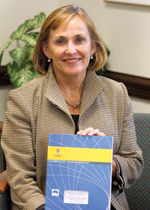|
by Dawn Brazell
Public Relations
Close to half of those
with post-traumatic stress syndrome (PTSD)
also suffer from substance use disorders.
That's why MUSC researchers Kathleen
Brady, M.D., Ph.D., and Sudie Back, Ph.D.,
hope to educate therapists and the public
about an influential change in how to best
treat this population. Brady and Back are faculty members in the Department of Psychiatry and Behavioral Sciences.
 Dr.
Kathleen Brady with her latest manual on
PTSD. Dr.
Kathleen Brady with her latest manual on
PTSD.
These MUSC researchers
collaborated with colleagues in Australia
to test exposure therapy, an
evidence-based cognitive-behavioral
treatment for PTSD and addiction developed
by the MUSC research group, in the
treatment of individuals with co-occurring
PTSD and addictions. The study was
conducted in Sydney, Australia in
collaboration with investigators from the
University of New South Wales.
Brady said that she
wasn't surprised by the findings,
published in the Journal of the American
Medical Association, that this patient
population could be treated for their PTSD
without worsening symptoms of addiction.
(Read the abstract here at http://jama.jamanetwork.com/article.aspx?articleid=1346186)
"Because this was
almost an heretical idea in terms of how
the treatment for this difficult portion
of the population had been, it really has
opened up a new avenue for treatment of
people with co-occurring PTSD and stress
disorders and addictions that is much more
efficacious and more humane."
The fact that these findings set a new
standard for handling treatment is
exciting to Brady, a longtime researcher
in this area. "This is an incredibly
common problem and so pertinent today
because we have so many veterans returning
from our recent wars with problems related
to PTSD and addictions. Therapists need
effective tools to address these
problems."
Another aspect that
made this study interesting is the
collaboration with MUSC and University of
New South Wales researchers, who used the
manual "Concurrent Treatment of PTSD and
Substance Use Disorders Using Prolonged
Exposure (COPE)" that was developed based
on work by Brady and colleagues.
"We have been working
in PTSD for a long time. We were the first
group who conducted trials exploring
medication treatments for this comorbidity
and have been involved in neurobiologic
exploration of the stress response in
individuals who have co-occurring
disorders," she said, adding that it's one
reason MUSC has become a specialty center
for PTSD treatment.
"Once you get a
critical mass in an area, it becomes a
magnet for new trainees and more
experienced colleagues who want to
collaborate and be part of the excitement
of new discovery."
Colleagues in Australia
read about the manual and asked to
collaborate on a study. Brady said they've
developed a close partnership, and it was
helpful to conduct the research there
given funding was easier to obtain and the
timeframe for the completion of the study
could be shorter. "It's such a rich
experience to interact with others who
come from a different perspective."
For the study,
researchers enrolled 103 participants, who
met the diagnostic criteria for both PTSD
and substance dependence. The subjects
were randomly selected to either receive
both prolonged exposure therapy and
treatment for substance dependence or to
only receive treatment for substance
dependence.
Those participants
involved with the integrated approach
spent the first few sessions learning
cognitive behavioral therapy strategies to
deal with substance abuse, and then they
were treated for their PTSD symptoms.
Brady said they focused on teaching the
patients the relationship between their
trauma and their addictions and how the
conditions are in a 'feed-forward, vicious
cycle.'
At a nine-month
follow-up visit, both groups experienced
reductions in PTSD symptoms, but subjects
in the integrated group also showed a
reduction in the severity of their PTSD
symptoms without any increase in the
severity of their substance use.
Brady said they've had
good experience with the integrated
approach so far. "We were true believers
that this works. We think this study will
change the way clinicians approach this
particular population, which is a
substantial number of people with
addictions. This will improve their
treatment and relieve their suffering more
rapidly than anything that has been used
before."
Beyond the scope of the
study is a bigger message. Brady wants to
see the moralistic thinking about
addictions change. It's not just a fault
of willpower or a societal issue to be
resolved by throwing people with
addictions into jail, one of the most
costly and least effective ways of
treating addictions, she said.
"The message I'd like
to get out to the lay public is that
addictive disorders are treatable
disorders. There's a neurobiology to these
disorders and there are effective
treatments. We need to support that. There
are a significant number of people in this
country and throughout the world who can
live much happier lives and make much
greater contributions. Why have people
suffer with addictions, waste their lives
and drain the resources of our society
when a relatively small investment in
treatment can lead to incredible gains at
the individual and societal level."
Friday, Nov.
16, 2012
|



 Dr.
Kathleen Brady with her latest manual on
PTSD.
Dr.
Kathleen Brady with her latest manual on
PTSD.